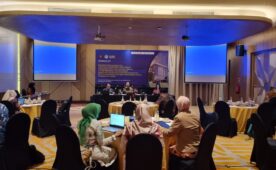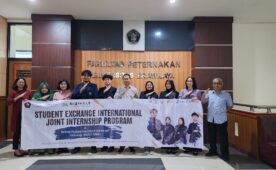
Yogurt is a drink made from milk fermented by lactic acid bacteria, such as Lactobcillus bulgaricus, Streptococcus thermophilus, Lactobacillus acidophillus, Lactobacillus casei, and others. The function of these bacteria is to break down lactose to produce lactic acid, and break down proteins and fats to produce various flavors of yogurt.
The benefits of yogurt for the body are regulating the digestive tract, antidiarrhea, anticancer, increasing growth, helping people with lactose intolerance, and regulating cholesterol levels in the blood.
This was conveyed by Dr. Abdul Manab in online training on making yogurt, Thursday (19/8/2021). He and the teaching staff who are interested in Animal Products Technology, Faculty of Animal Science Universitas Brawijaya (Fapet UB) carry out community service activities that are wrapped through the training.
The team involved is Dr.Purwadi (chairman), consisting of Dr. Manik Eirry Sawitri, Dr. Abdul Manab, Dr. Imam Thohari, Dr. Khotibul Umam Al Awwaly, Dr. Agus Susilo, Dr. Dedes Amertaningtyas, Dr. Mustakim, Dr. Premy Puspitawati Rahayu, Ria Dewi Andriani, M.Sc, and Mulia Winirsya Apriliyani, MP.


Participants in the training activities came from various groups ranging from housewives, vocational students, students to employees. The hope is that after participating in the training, independent small business groups can be formed that generate profit income for the family.
Manab said there are two types of yogurt, namely plain and drink. Plain yogurt is yogurt that has not been mixed with other ingredients, and is a semi-finished ingredient for making yogurt drinks, yogurt masks, yogurt toppings, and so on. Although it tastes sour and bland, it has a higher nutritional value than milk.
While the yogurt drink is a variant of yogurt with a watery consistency and is a public favorite. This product can not only be made at home with additional flavors according to taste.
Then the material for making yogurt was presented by Dr. Purwadi who already has a business called the yogurt house. According to him, the initial stage of making yogurt is pasteurizing milk to kill all pathogenic microorganisms, killing most spoilage microorganisms, and inactivating enzymes that are naturally present in milk.
Then the temperature of the milk is cooled by soaking or flowing cold water. Next, inoculate the starter bacteria using an aseptic container to avoid contamination with microorganisms from the outside.
Then fermentation with an optimum temperature of 42 degrees Celsius for 4-5 hours followed by room temperature for 18-20 hours. The goal is to give bacteria the opportunity to grow properly so that it produces a sour taste and forms lumps.
After clotting, it is immediately harvested so that the fermentation process does not continue, stored and tightly closed. Or before storage can be added various flavors and colors according to taste. (dta)
Berita Lainnya




Pengumuman





 Indonesia
Indonesia